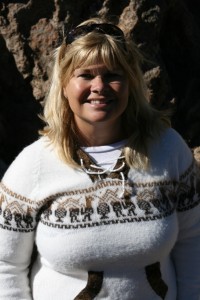 Me in my new Peru sweater (Don’t I look happy?)
Me in my new Peru sweater (Don’t I look happy?)
Normally we don’t like group tours. We prefer to come and go as we please. Colca Canyon was an exception as we couldn’t work out for ourselves how to get there. It became the highlight of our trip.
My primary interest in Colca Canyon was to see the Condors. This was one of the few habitats left for them in Peru. These birds are a legend, living up to 50 years and having a wingspan up to 10 feet. Because they are so heavy, weigh they tend to live near canyons, counting on the updrafts to keep them aloft. In addition we would be seeing parts of the Colca Canyon, a canyon nearly the world’s deepest canyon, twice as deep as the Grand Canyon, and what we were later to find out, some really high altitude.
The bus came for us at 8:30am. We had checked out of the hotel and brought our bags along as we would head straight to the bus terminal after the tour, catching a bus for Cusco. the price of the tour ($20.00 US per person) included the bus to Chivay, hotel room in Chivay, hike to the hot springs, a local folk dance, and the trip back at around 6pm the next evening. I was still unable to keep any food in, so I knew I would not be eating that day. Our guidewasIrene and she spoke good English. Our first stop was a roadside cafe/arts, where Irene suggested we order the tea that would help with altitude sickness. In addition, Dan and I had bought some Coca leaves, which Irene showed us how to use. You take a group of leaves, strike them with a rock that has some limestone in it, then put the leaves in your mouth. After a few minutes your cheek will become numb. We made a few stops along the way to see the Alpalca and Llamas along the way. By the second or third stop, there was no way I could get out of the bus. Irene asked me how I was feeling. I told her I didn’t think it was just altitude sickness, that it might be food poisoning. I can’t remember the last time I had food poisoning, let alone had been sick! But, I did eat the raw spinach at the restaurant in Arequipa (I was the only one) and I think that was it. Luckily a fellow traveller came to my aid. A guy named Graham, a nurse from England, asked me what was wrong. He told me he had something that might help. It was called Cipro. Cipro! Only the best, strongest antibiotic in the world! He said his friend Tony, sitting next to him, had the same symptoms before, and he took a Cipro and it really helped. He starts assuring me they are safe and reading me the fact sheet, but all I’m hearing is Cipro and I really want it!!! Sure enough, about an hour later, problem solved. But now the true altitude sickness kicks in. At one point, Tristan goes to the world’s highest bathroom and records, with his GPS, an altitude of over 16000 feet! Let the nausea and headaches begin!! We stopped for lunch and I waited outside while the rest of the group ate. Dan started getting sick at that point. After a late lunch we headed to our Hostel for the night. Irene said she would be leading a group hiking to the hot springs in an hour, but Dan and I were in no shape for it.
We were staying in a Hostel, not a hotel, so that meant single beds for all. Our room was clean, but small, just enough room for 4 single beds. Dan and I didn’t care. Our heads hurt so bad all we wanted to do was sleep. There was no TV in our room, or in the Hostel, so it was up to the kids to entertain themselves. The heat hadn’t come on yet, so it was cold, but the bed had about 4 heavy blankets on it. It was warm under the covers. The kids had to entertain themselves. When I woke up later, the room was dark, Tristan was under the blankets reading the Lonely Planet guide with a flashlight and Tessa was under the blankets with the IPOD. Dan and I seemed to be getting worse. I remembered I had the altitude sickness pills, but I thought I only bought a few and I wanted to save them for our trip to Machu Picchu (which I later learned is much lower than where we’ve been!). Finally I broke down, got the pills our and Dan and I took 1. That was when I noticed I had actually bought ten pills. Within the next 2 hours we started feeling better and by morning, after a much needed hot shower, we took another pill and really felt good.
Thank goodness, because today was all about the scenery.
Chivay is a unique town. It technically sits in a valley, but the valley is at an altitude of 3630 feet (11909 feet). to put that in perspective, Chivay valley is higher than the mountains at Vail Colorado. As the bus took us toward where would see the Condors, we pass rings of terraces surrounding the valley and rippling up the mountains. the agriculture here is amazing. Peru grows over 1700 varieties of POTATOES. Can you believe it? Also on the hillsides, corn, quinoa and onions are grown. The terraces follow a plan that was laid down over 500 years ago by the Incas. The lower level is the corn and further up the mountain, hardier vegetables like potatoes. Even at the lower level, it’s still cold at night for corn, so the Incas came up with a great idea. They surrounded the square fields with thick fences of rock. During the day, the sun heats up the rocks, and at night, the wind blows the heat off the rocks and keeps the crops warm. They invented their own microclimate.
The scenery here is truly breathtaking. At certain vantage points, you can see the Canyon and the darkness of its depths, and then look up and see snow capped peaks. Amazing! Most importantly, you can feel the mountains. Really feel them. And it’s a great feeling. Like someone loving, watching over you, protecting you. The mountains feel very much alive and they are. They are still growing, one guide told us over 10 feet per year (though I’m not sure how accurate that is). It’s easy to see how the Inca’s thought of them as Gods. They have an energy you can’t forget.
Our bus arrived at Condor Crossing around 9:30 am. This was the best time to see the Condors. We weren’t disappointed. Within a few minutes of our arrival, a huge condor flew right over our head. We oohed and awed for awhile, then got back into the bus for the second viewing location, where we stayed for an hour. Here we were rewarded with a male, female and a juvenile condor. Watching these enormous birds glide so easily on the updrafts from the canyon, you can’t believe they can weigh nearly 30 pounds. Not to be outdone, a few hawks came by and demonstrated their gliding ability as well as their ability to hold themselves motionless, in one spot in the air, as their sharp eyes raked the mountainside for food. We had quite the show!
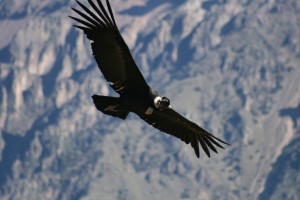 Condors
Condors
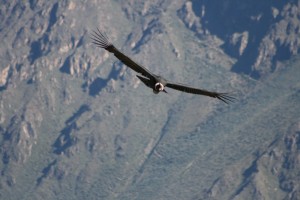
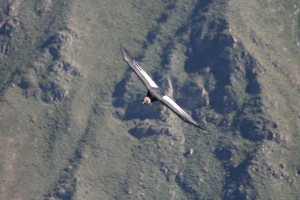
Before we headed back to the bus, Tessa and I did a little shopping with the ladies who had set up their wares along the roadside. I bought a sweater, gloves and a scarf for Tessa and I. The sweaters were supposed to be hand knit Alpaca. I’m not sure if it was Alpaca or wool, but at $8.00 US for a sweater, and $2.00 for the gloves, it was a bargain. Plus, they were so soft and so warm, and they turned out to be lifesavers over the next few weeks.
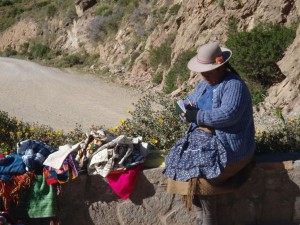 Women selling their handicrafts
Women selling their handicrafts
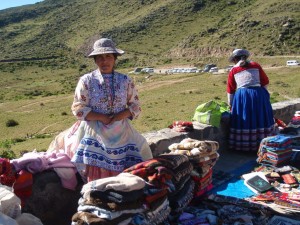
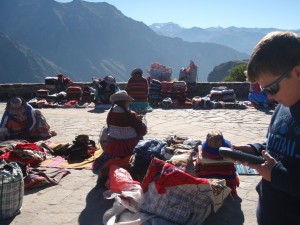 Roadside shopping while Tristan checks the altitude with his GPS
Roadside shopping while Tristan checks the altitude with his GPS
It was more great scenery as we headed back toward Arequipa. The tour bus was due in around 6pm and we were to catch our overnight bus to Cuscoat9 pm. Along the way back, our tour bus stopped and picked up another tour guide Judy. She had been leading a hiking group up to the top of the volcano El Misti. She sat in the back of the bus with us and overheard me asking Dan (a school teacher from New York) and Graham about a good place to stay in Cusco, as we were headed there tonight. She interupted and asked me if I had checked to make sure the bus was still going. Apparently, there was a protest in Juliaca (which we had to go through) and the roads were blocked.
We had read on the news two weeks before that this had happened. The farmers were mad about something to do with water rights. We never got a good answe, mostly because this happens quite frequently, according to Judy. Thrproblemwas tourists may not know about it until too late. Here’s the problem. If you are on the bus and you run into a protest area, the bus won’t go on, and you are left on the roadside in a protest, no refund, no transportation. If you ask before leaving “Hey. Any protests, anywhere, I might need to know about?” They have to tell you, and give you a choice to rebook or take your chances. It’s a “If they don’t ask, you don’t have to tell” policy.
But our bus line Cruz del Sur was one of the more expensive ones in Peru, well researched by Tristan just so we wouldn’t have these kinds of issues, (or robberies, or buses going off cliffs, you get the idea). Really Tristan’s research consisted of part gut instinct and which bus looked the newest and coolest.
Hey it worked.
When we checked in that night we were told the bus was cancelled. We would have to go the next night instead. The really bad news? Our seats on this bus was the fully reclining VIP seat, as it was a nine hour overnight trip. Those seats for the next night, and the night after that were all booked. So we were back in our “nearly fully reclining seat” called a semi cama. At first, she was not going to refund the difference in the ticket amount. She was as equally surprised that we expected her to as we were that she thought she wasn’t going to. After a call to her supervisor, we were refunded the difference.
Now we needed a hotel for the night. The easiest choice was back to Posada de San Juan. The hotel was fine. It was a great location, free transport from the bus station, (although taxis in Peru are cheap, around $1.50 US), our room had the amazing view of the volcano, but the front desk people spoke next to no English. Dan and I differed on our feelings on this. He felt that since they held themselves out as a tourist hotel, they should speak good English. I am more of the “We are in a Spanish country, we should speak more Spanish.” What really got me though was the girls at the front desk, in addition to speaking no English, were low talkers. I mean they spoke so quietly, I couldn’t ever hear them let alone try to interpret them. Plus, one of the other ladies there had yelled at Tristan for being on the computer, yelling at him in Spanish. Tristan figured out she thought he was playing games when he was actually looking up the bus schedule. Linda (our Australian friend) explained to them later what he was doing. Anyway, back to the hotel, back to the same room. After settling in we dashed across the street for a quick bite. Dan had the Lomo Saltaldo, and we ordered 2 Fried Rice dishes. The portions were huge. We couldn’t finish them. The total price? $3.00 US. Unbelievable. And no one got sick later!
It was actually good to spend another day in Arequipa as we got to see more of the city. Linda also helped us find a lavenderia to have our clothes washed. There was one at the hotel, but they were line dried and we were leaving that night. Also there was one across the street but Linda said that wasn’t a good one. So she proceeded to take us on a ten block tour trying to find one that was open. I didn’t think Dan was going to make it. She walked so fast (another trait of Peruvians, they are quiet and fast) that he, carrying the heavy bag of laundry at an altitude, nearly had a heart attack. Linda was trying to be so helpful, but really she was taking us so far from the hotel, and seemingly wandering in circles, all the while telling us horror stories of Cusco and how people there will “squirt mustard on us and steal our wallets” or “Slash our backpacks” or “Watch your children” and “Don’t even think about wearing an expensive watch there!” Trying to keep track of the “do’s and don’t’s of Cusco” keeping an eye on Dan’s deteriorating medical condition, and trying to remember how to get back to the hotel, well, it was a little overwhelming. Every time I would try to sneak into the conversation that “wasn’t there a laundry across the street from the hotel”, my words fell on deaf ears. Dan, staggering behind us by about ten feet is getting very testy though. He’s stopped being subtle.
“This is crazy! There’s a laundry right across from the hotel!” I shot him a look that told him to stop being rude. Diane just went on in her Australian accent “You want to have one that doesn’t wash your clothes with someone else’s. That’s a trick you know! They’ll mess up your laundry. You don’t want your clothes coming out a different color eh?”
I turn to Dan. “Eh? Want your clothes a different color?”
We keep going. Every corner it’s the same. “One more block this way.” Behind us Dan is getting louder. “This is stupid!” I’m stuck listening to more of Linda’s life story about everything negative that happened to her, hoping she won’t hear Dan.
Dan: “This is stupid!”
Me: “Really! Took all your money huh?”
Dan: getting louder “I’m going back!”
Me: “Really! Stole your house and your husband? Incredible!”
Dan: “I mean it!”
Me: “You don’t say! Just squirt mustard on you and take your money?”
Dan: “Carla”
Me: “Really! Your hair just caught on fire huh?”
Finally, we arrive at the laundry, which, after all the circling around, ends up being only 5 blocks from the hotel.
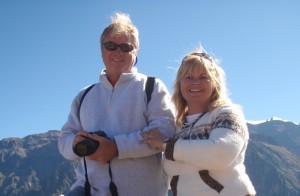 Dan and I having a great time!
Dan and I having a great time!
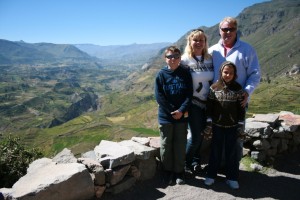
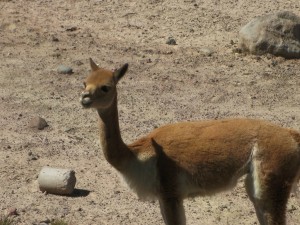 Vicuna
Vicuna
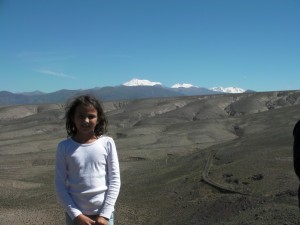 Look at those snow peak mountains in the background
Look at those snow peak mountains in the background
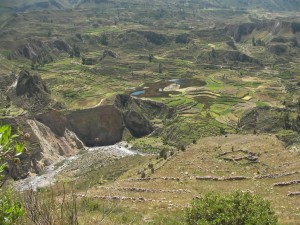 Incredible views
Incredible views
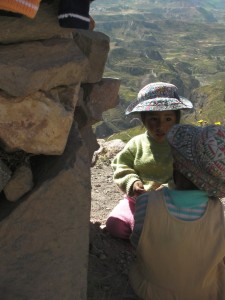 Helping Mom at work
Helping Mom at work
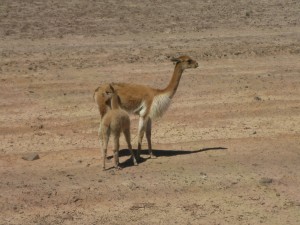 Mom and baby Vicuna
Mom and baby Vicuna
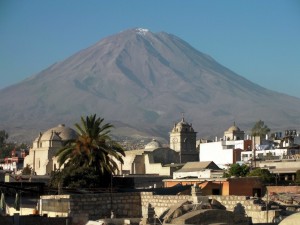 El Misti Volcano. Notice the snow is melted off the peak. It’s a semi active volcano
El Misti Volcano. Notice the snow is melted off the peak. It’s a semi active volcano
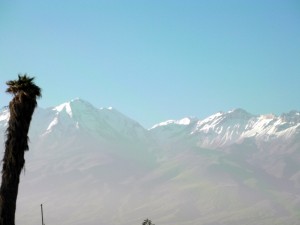 More snow peak mountains from our hotel
More snow peak mountains from our hotel
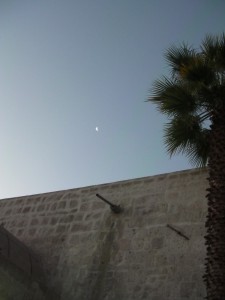 Moon over Arequipa
Moon over Arequipa

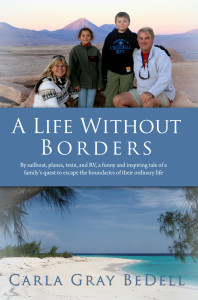
Write a Comment
You must be logged in to post a comment.